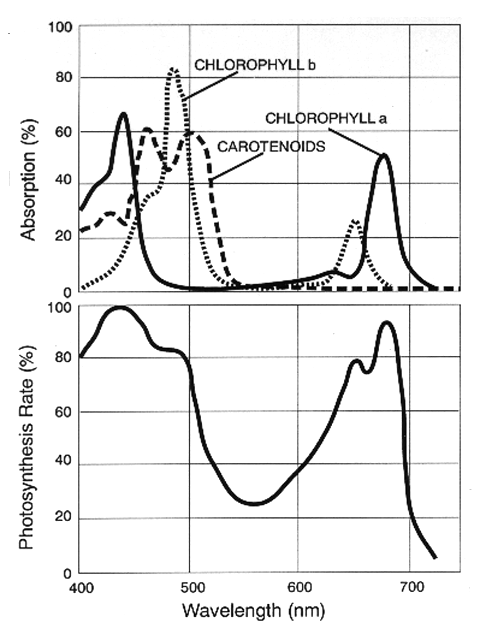
 |
|
#11
|
|||||
|
|||||
|
Quote:
__________________
Eugene |
|
#12
|
|||||
|
|||||
|
Quote:
So just because an LED doesn't suffer the same spectrum shift as other bulbs doesn't mean the PAR rating will be unaffected, it simply means you won't notice a change in color overtime, only intensity. |
|
#13
|
|||||
|
|||||
|
Quote:
The way spectrum works is, too far right, the spectrum isnt used, and same goes for to far let. if the bulbs we had originally were spiked at 450nm and spectrum shift it to 500nm in a year, all that blue light turns into green. Corals dont utilize green light very well and the and useful PAR goes down. Then everything in the 650nm-700nm range literally just disappears from the usefull radiation spectrum and moves into IR range.
__________________
Eugene |
|
#14
|
|||||
|
|||||
|
Quote:
 You can see that chlorophyll likes blue and red but not much in between. Now here is a good article on the spectral output of various MH lamps: http://www.personal.psu.edu/sbj4/aqu...omparison.html Here is the output of a 10,000K Ushio bulb as an example:  So as that big blue peak not only decreases but shifts over the the right you get less real useable PAR since the green part of the spectrum is less efficient then the blue and red in terms of photosynthesis. The situation is probably even worse with 14,00K and 20,000L bulbs that have more blue and less red in their spectrum. Here's a 20,000K bulb:  So yes, the lack of spectral shift in LEDs is a big advantage in that you stay in the peak output frequencies for photosynthesis. I imagine the T5s etc. put out similar spectrums as some of the MH lamps so the situation is similar. |
|
#15
|
|||||
|
|||||
|
Eugene beat me to it but I had diagrams
|
|
#16
|
|||||
|
|||||
|
Nice summary with good data and purty pictures. LED FTW
|
|
#17
|
|||||
|
|||||
|
__________________
Eugene |
|
#18
|
|||||
|
|||||
|
While I applaud your skills of posting diagrams exactly how is posting diagrams of bulbs running with different ballasts relevant to bulb life? I also obtain the skills to post diagrams from articles however I will post ones more relevant to the discussion.
First we can look at the same bulb at 0 months and 17 months:  While the AVERAGE spectrum or CCT will shift in one direction the actual plot does not actually shift but rather decrease in certain areas while increasing in others resulting in a new CCT. Typically the intensity of the blue will decrease but depending on the ballast you use the other areas of the spectrum will actually increase maintaining your total PAR but changing the overall color of the bulb. Here we can see PAR readings of the same type of bulb over time  Clearly shown is a steady par reading but a decrease in CCT So we can pretty clearly conclude Quote:
The reason you don't see the change in CCT with LEDs is simple. The spectrum is much more defined and concentrated over a smaller area. The intensity simply decreases over time and since it lacks the other wavelengths there is no increase in other sections keeping CCT constant. So once again the change in PAR is more directly connected to the change of intensity of each wavelength that makes up the Photosynthetically Active Radiation (PAR) and not necessarily the overall change of the Correlated Color Temperature (CCT). Also there is more to PAR than just red and blue Quote:
http://www.advancedaquarist.com/2008/7/aafeature1 http://www.advancedaquarist.com/2006/8/review2 |
|
#19
|
|||||
|
|||||
|
Quote:
The posting of a graph is not to show different different ballasts used but the spikes in individual ranges. I'll agree with you that PARs values change according to the change in intensity of different wavelengths but how is that different with a shift in the spectrum? (might just be my way of reading it that i see them as the same). So would you say that the PAR value decrease is correlated to a decrease in intensity and color spectrum shift not intensity alone? now that you've mentioned that its % of intensity drop in certain spectrums. Its true that theres more to red and blue in PAR but those are the 2 main spectrums that plants/corals utilize. There is a need for green/yellow but the 2 most utilized spetrums are red and blue thats why i only mentioned the 2. This discussion is interesting!
__________________
Eugene |
|
#20
|
|||||
|
|||||
|
Quote:
So I guess to sum up what I'm suggesting is a decrease in par is a result of an overall decrease in intensity while a change in CCT is a result in a shift or varying fluctuation in intensity over different wavelengths. CCT and PAR are not directly related when we're looking at bulb wear. So when comparing LEDs to halides, LEDs will still suffer from a decrease in intensity and therefore PAR but the rate of reduction of intensity in LEDs is less than halides. The narrow spectrum in LEDs makes the change in CCT is basically unnoticeable while halides suffer greater changes due to the more broad spectrum. So LEDs obviously last longer but halides are cheaper and easier to replace and by selecting bulbs with a more concentrated spectrum in the right areas you can extend you bulb life dramatically. |